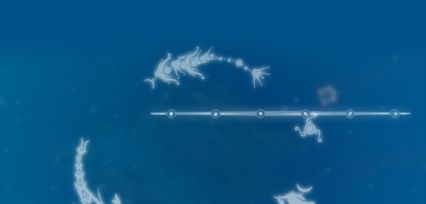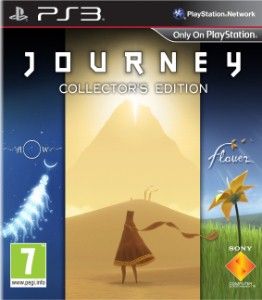- Format: PS3
- Unleashed: Out Now
- Publisher: Sony Computer Entertainment
- Developer: thatgamecompany
- Players:1-2
- Site: http://thatgamecompany.com/games/journey-collectors-edition/
The disc may carry the title ‘Journey: Collector’s Edition’, but that’s somewhat misleading. Also included are thatgamecompany’s other two PS3 exclusives, as well as a nice little bag of bonuses. Already cheaper than buying the games separately, how much value does it actually represent?
Tackling the three main games chronologically, we first turn to the uncomfortably-typed flOw. The pretty colours and abstract shapes depict, in a typically intelligent and unexpected way, an aquatic world. The premise is simple; relying solely on the DualShock’s sixaxis controls, you bob and weave your creature through the environment doing your best to eat (and not be eaten). Each ‘stage’ is in effect a new step in evolution, with your unnamed fishy thing slowly becoming larger and more complex.

I spy with my little eye…er….
It’s strange yet satisfying to steer clear of a certain weird yet wonderful creature, who would and could do you harm, and then a few short stages later find that you have changed from prey to predator. It’s not simply a case of ‘eat X number of creatures, advance, repeat until game is over’. You can choose, to an extent, how you want to play; for example, the trophy list encourages varying speed and aggression. It’s an attractive, unique and relaxing game, with legions of fans – but it is, we would argue, a weaker title than the next two games.
In fact it could be argued (and we shall do so here) that middle child Flower is the best game in the collection, and one of the best games available for the PS3 full stop. It’s also extremely difficult to describe without making it sound dull. Does it help if we say it’s a third person petal ‘em up? Probably not.
As with flOw, sixaxis controls are required to play. At the beginning of each stage, the camera focusses on an unopened flower. Hold down any button and the flower blooms, releasing a petal. You’re then put in control, tilting the controller hither and tither to blow the petal around the environment. You’re looking for more flowers, of which there a great many. Each one you bloom increases your petal count just a little, until you’re directing a wonderful orchestra of petals around the stage.

Petal to the metal
The game looks wonderful, and is accompanied by an impossibly gorgeous soundtrack – which your actions interact with in a similar way to Rez or Everyday Shooter. There is no pressure to the game whatsoever, and you can drift around at your own pace. You’ll soon find yourself zooming along at the surprisingly fast top speed however, determined to bloom a whole twisting line of flowers without missing a single one; until you yet again transform the surrounding ground into a lush, untouched paradise of colour.
Surprisingly perhaps there is a story, told via semi-animated cutscenes. The general theme is one of the beauty of nature versus the relentless expansion of urban environments and, when the game starts to push against the player slightly in the final stages, the experience loses a little lustre. It remains nonetheless a beautiful game in every sense, and one which you need to play.
Then we have the eponymous Journey, a title waved around by certain areas of the games press during tedious ‘games are art’ arguments. It is in fact the closest thing to a traditional videogame here. You have an anthropomorphic avatar controlled with a combination of the left stick and buttons; you explore, and you jump; there are cutscenes; motion controls are not compulsory. Journey is nonetheless far removed from a traditional videogame experience – and is all the better for it.
Keeping with tradition, there is no dialogue whatsoever. Events are explained visually during the religion-flavoured cutscenes, but it is during gameplay that the bulk of the story lies. As you explore the desert, gently guided by the invisible hands of masterful game design and smoothly integrated visual cues, you will uncover much – all of which is open to interpretation. There are hidden glyphs, ruined structures, mysterious creatures, and more. To elaborate would be to begin to ruin the experience – especially as, notoriously, the whole thing can be finished within two hours.

“Oh Sandy ba-ayby…”
Journey does have replay value, though not many will jump back in immediately. It’s unlikely you’ll see everything in your first playthrough – and the online mode, where another player joins your game anonymously, holds a strange attraction. You communicate with one another only through brief snatches of an indecipherable language which, while certainly limiting, keeps with the mysterious mood of the game perfectly. Said mood is largely created by yet another wonderful soundtrack, and a bold art design which – especially in the final moments – gives the impression of a game running on a much more powerful machine.
If you buy the disc-based version of the collection, you’ll run into a baffling frustration. Despite being a retail release, each game still needs to be installed and, for extra inconvenience, have the disc present in order to play. The extras more than make up for this, though; themes, developer commentaries, and – best of all – the soundtracks, which can even be exported to another device. Also included are three games from thatgamecompany’s GameJams, each created within 24 hours. They’re certainly not going to keep you entertained for weeks on end, but each allow for a few minutes of fun with a friend – and it’s interesting to see these basic, though very different, projects that the developers produced to keep themselves on their toes.
If you’re missing at least two of the three main games, you have no excuse to not buy this. If you have all three but you’re one of the many fascinated with everything thatgamecompany does, the extras alone justify the budget price for you. Journey: Collector’s Edition slipped into shops with no fanfare; but it’s worth a hundred Call of Dutys.










I found this for about £11 a good few months ago. I bought it straight away because A) I’m a massive fan of ThatGameCompany, B) I’d rather have a physical copy to actually, y’know, keep safe and C) I wanted the soundtrack to Journey so badly that I’d have happily paid even MORE for this collection just to have it. There’s no escaping the fact that what TGC are doing with their games is nothing short of genius and have shown to us that if thought about properly, games can be so much more than generic corridors splattered with blood. I won’t harp on about how each game in it’s own right are forms of art but I will say this; they’re an EXPERIENCE. A proper, emotional, experience. That’s just a good combination of good story-telling, exceptionally nice visuals and of course, involving musical scores.